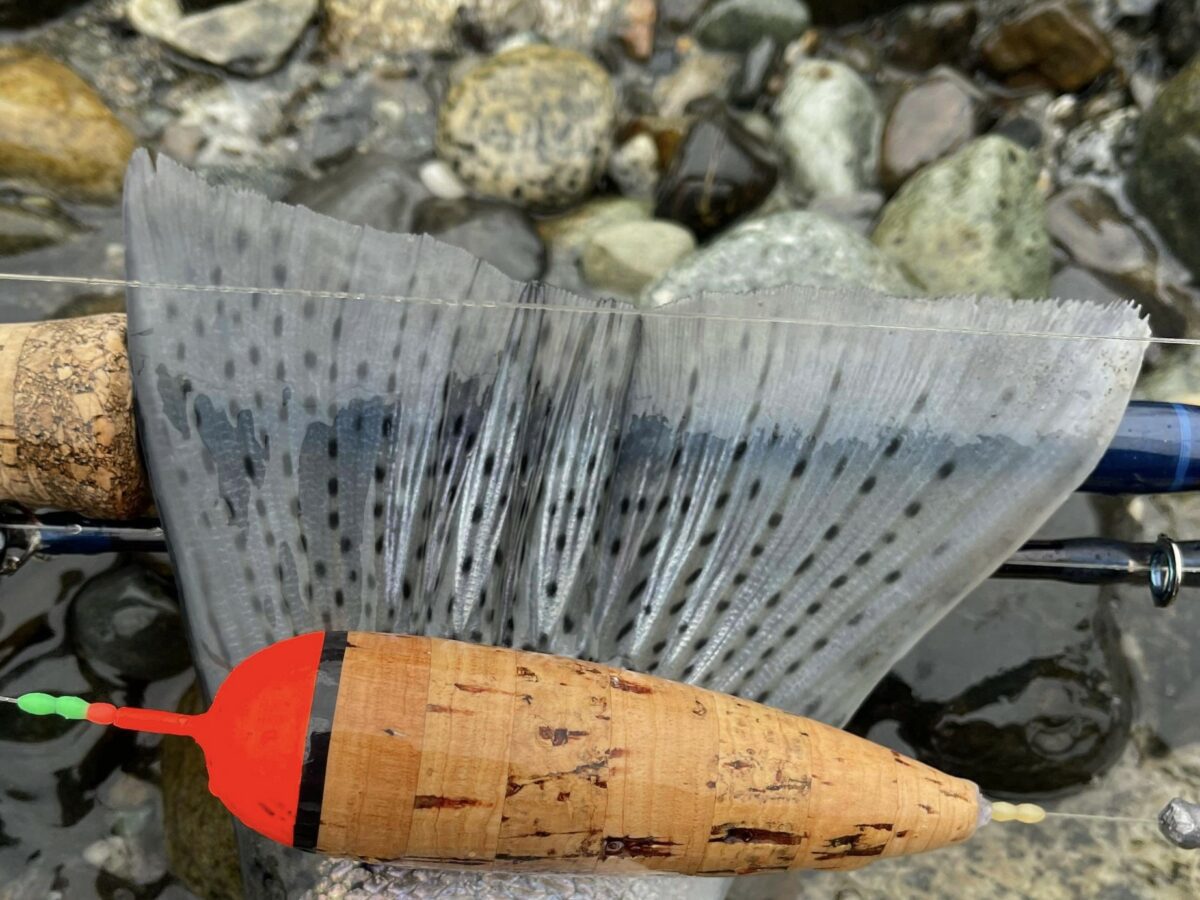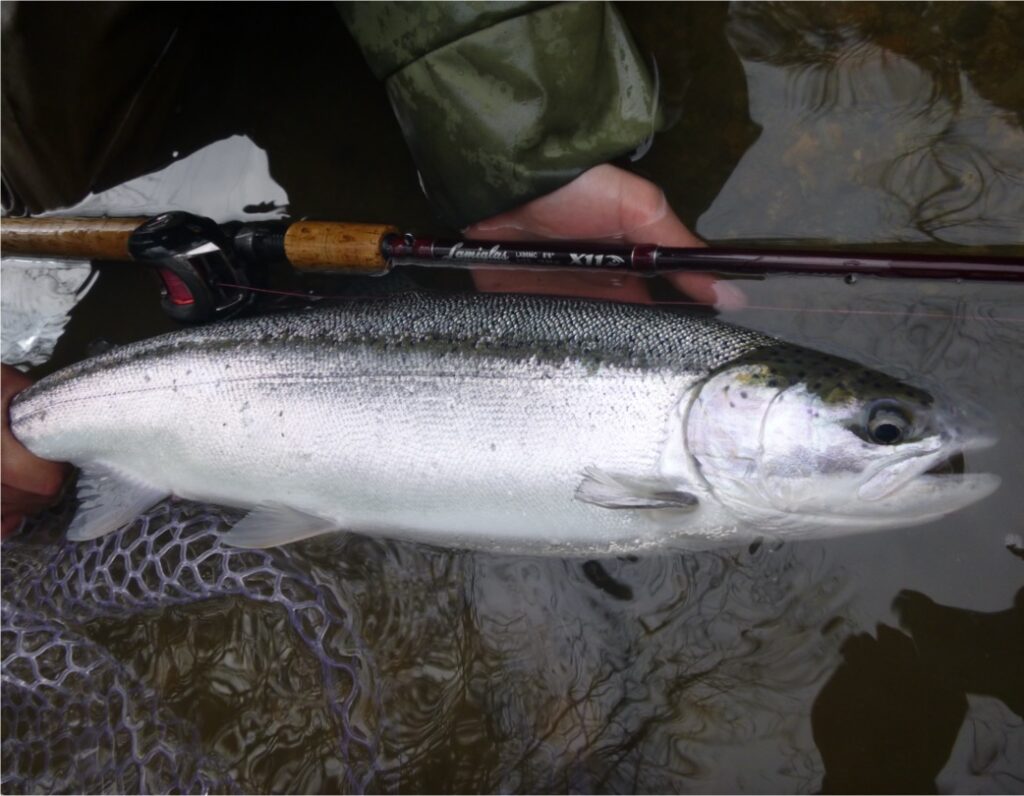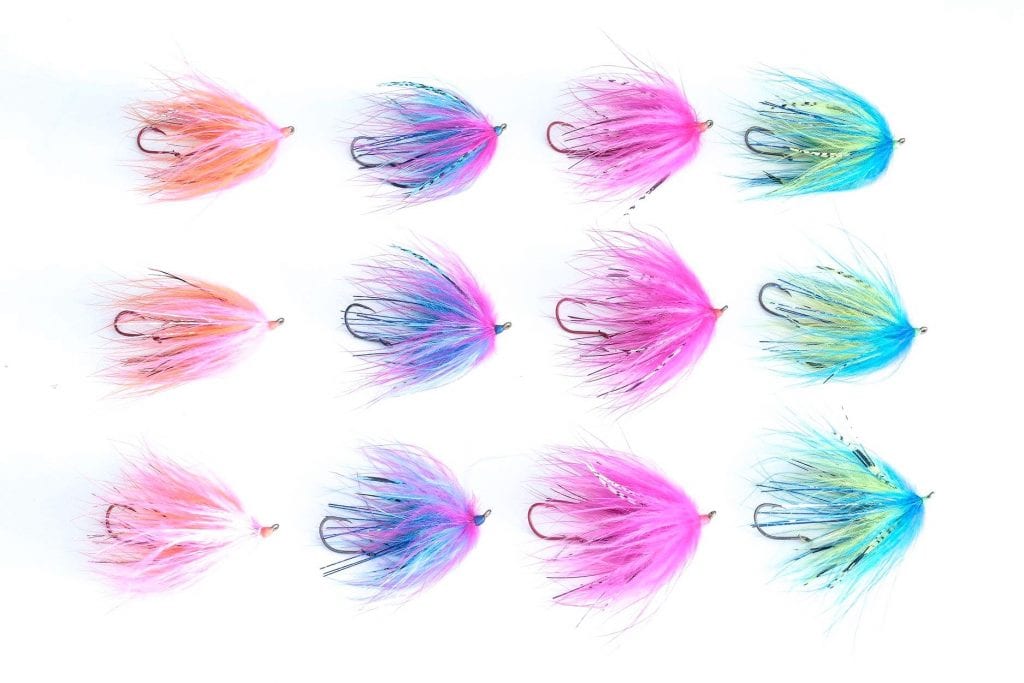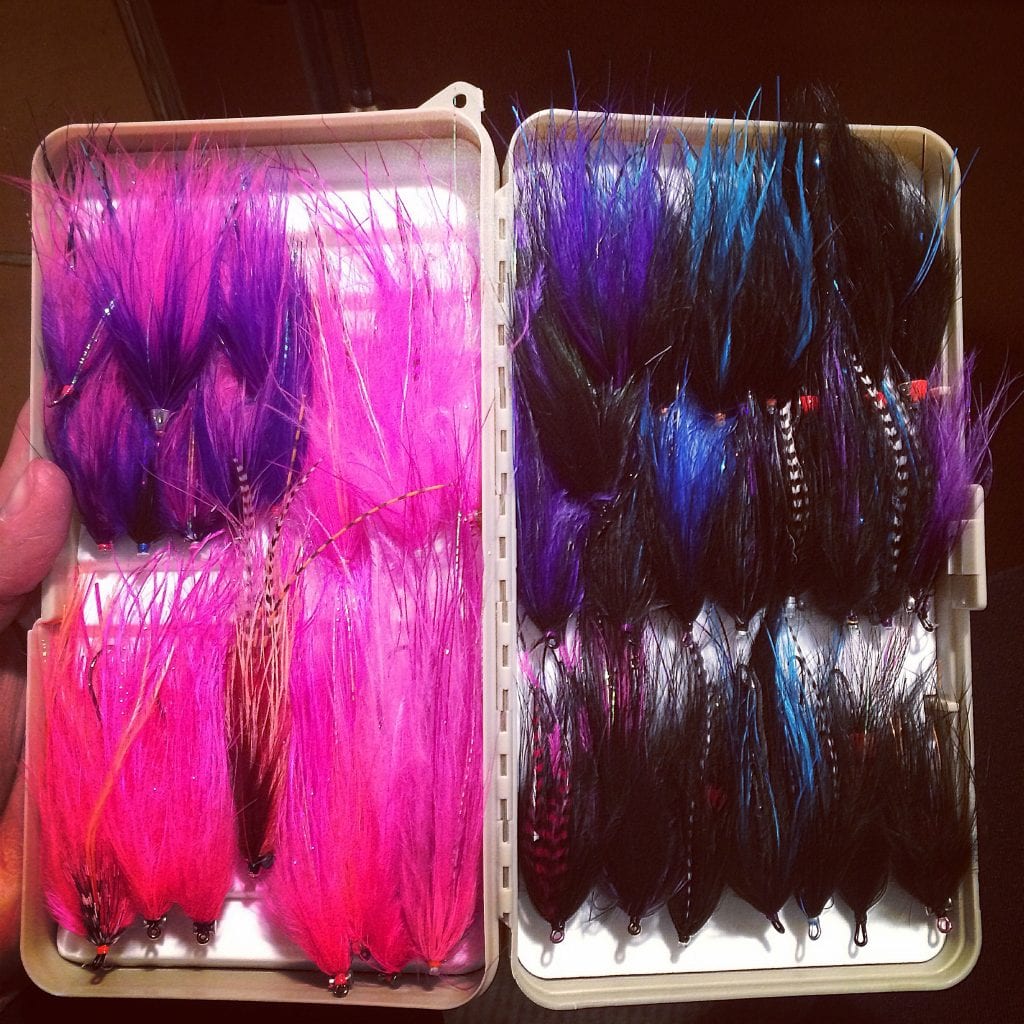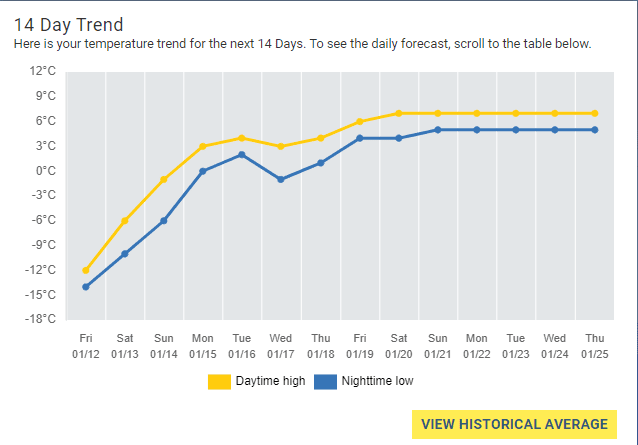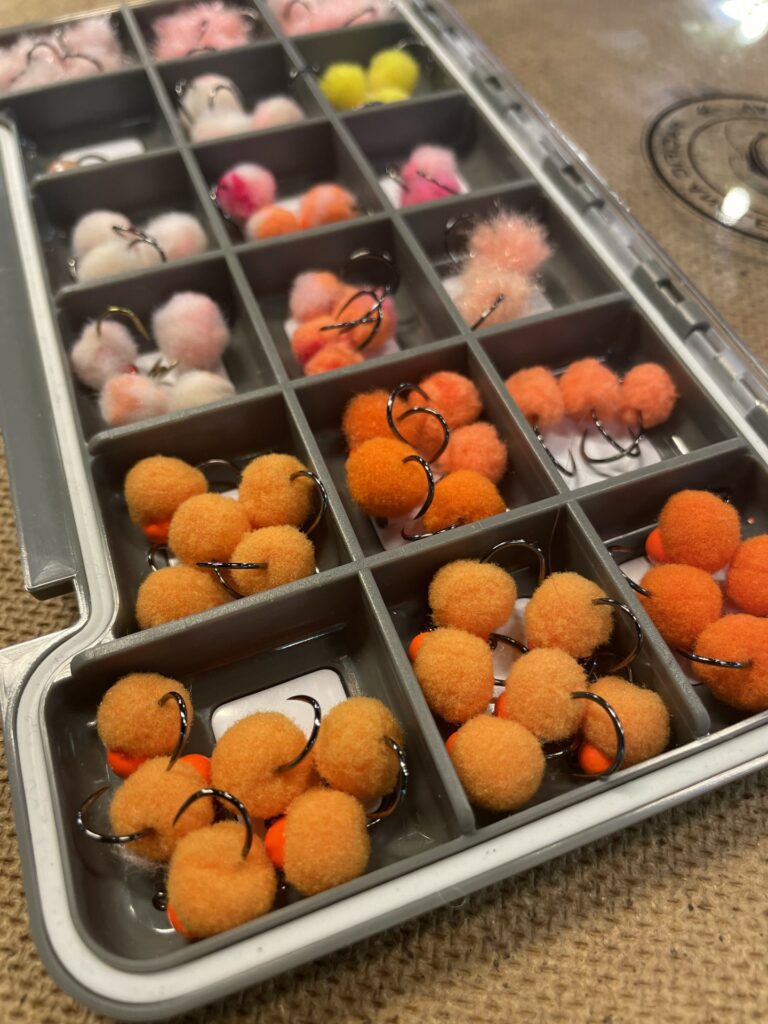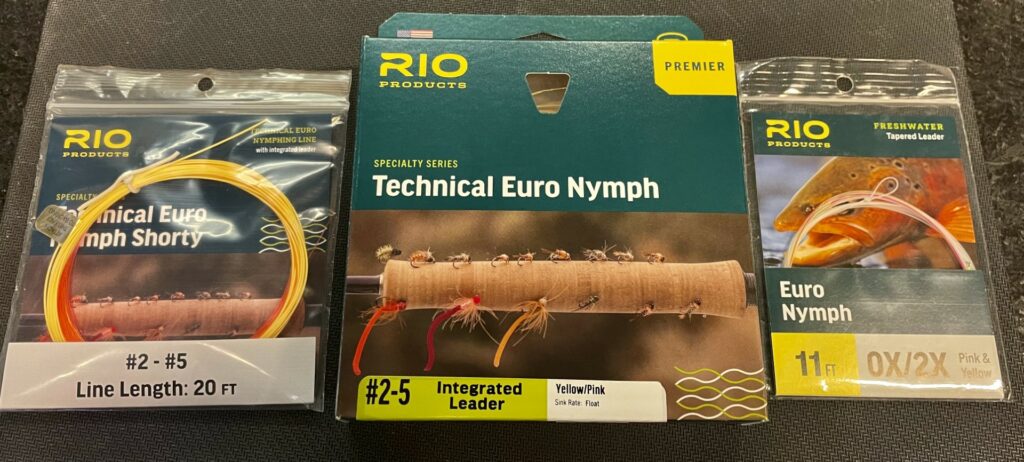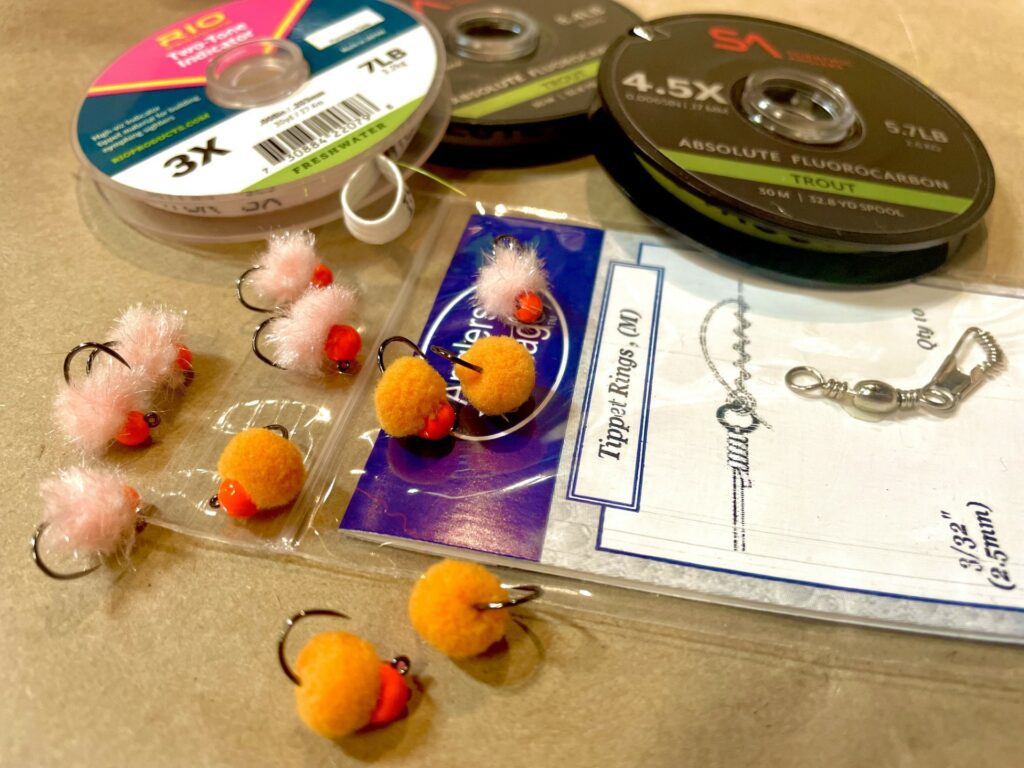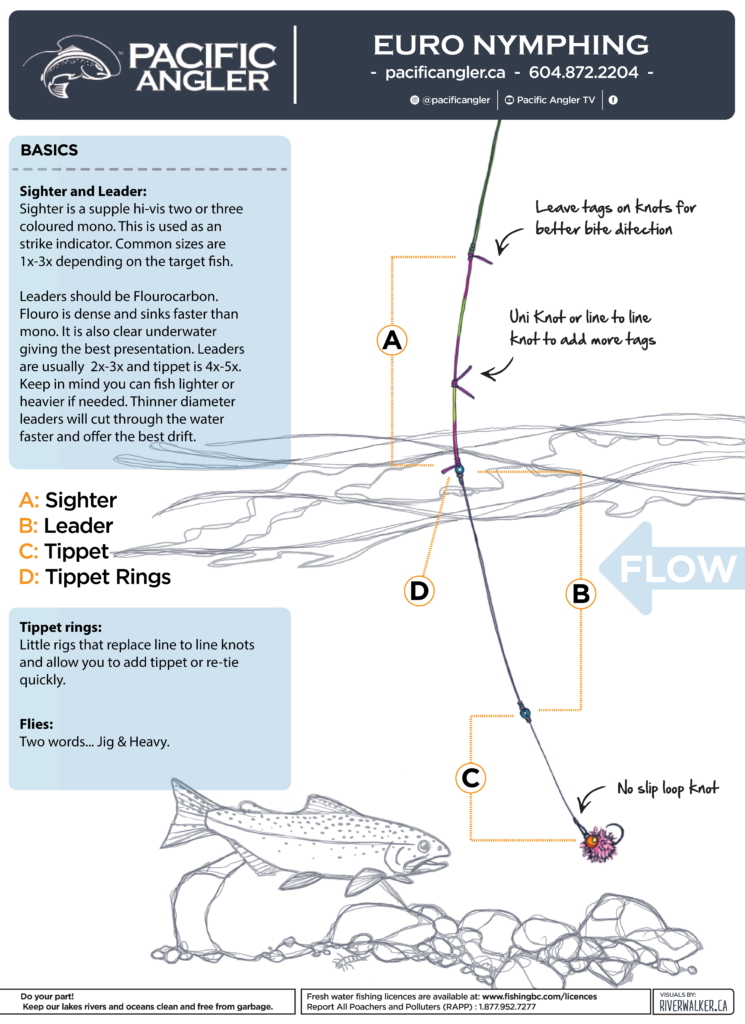OUTLOOK
Incoming cold snap! If you poked your head out the door at all in the last 24 hours you will know that we are in the middle of our first real cold snap of the winter. With it, fishing will slow down across the board. Reports were great on both the saltwater and rivers last week, but we expect much slower reports with snow and very cold temps right across the region for the next 2-3 days. Things should be warming up next week but, until then, batten down the hatches, make sure the boats are winterized and maybe tie some flies.
If you are brave enough to get out, steelhead are the one species that doesn’t seem to be as adversely affected by cold in the same way that bulltrout and resident river species are affected. It might we worth a snowy hike on the Chilliwack. Taylor has some details on this fishery in his report below.
Another one to start thinking about is cutthroat fishing. They are also not as temperature intolerant, and you might take some time to do some scouting or Google map searching because this is another cool fishery to look at in January – April.
Lastly, Eric has an article on Euro (straight line) egg nymphing. This is a perfect technique for cold water fishing in our rivers that have salmon eggs and the species that love eating them. Check that out below the Squamish River report below.
On to the report!
COURSES
We are looking forward to getting back in the classroom and on the water with you in 2024!
Steelhead Float Fishing
In this fishery, 10% of the anglers catch 90% of the fish. This is your chance to learn from the 10%! Our 3hr evening seminar will educate you on the gear, water types, conditions and other key variables that put veteran steelhead anglers in that 10%. Mastering this fishery will make you the envy of your friends.
Seminar: January 16, 2024, 6:30PM-9:30PM
Cost: $75+GST
Fly Fishing Egg Patterns
This course is designed to teach you the secrets to one of the most productive presentations in the BC fly fishermen’s arsenal; nymphing egg patterns. This deadly method can be used for different species of trout, char, and salmon. During a 3 hour evening seminar we will teach you key concepts, strategies, and gear that will give you a well-rounded foundation during the seminar portion of the class. Then you will put those skills into practice during a fully guided day on the water
Seminar January 17, 2024 – 6:30PM-9:30PM
Guided January 20 or 21, 2024 – Full Day
Seminar Only Cost – $75+GST
Seminar + Guided Day on the water – $325+GST
Tying Intruder Patterns
In this one night course you will learn about the specifics techniques and unique materials used to tie Intruder style flies. At the end of this course you will have the skills needed to tie a variety of Intruder style flies from multi stage, monster flies for high water, average sized flies for everyday conditions, down to small, mini intruders for low water. Note that this course is suitable for intermediate to advanced tiers. Students are required to supply their own vise, tools and materials. A 10% discount is available on materials and tools purchased for the course. A detailed list of what materials are needed will be supplied in advance of the course.
Date: Feb 7, 2024
Cost: $75.00+GST
Time: 6:30pm – 9:30pm
Tying Essential Steelhead Patterns
This course is designed for the fly tyer looking to get the best start on tying steelhead patterns. In the 3-hour evening seminar your instructor will cover everything from tying techniques, material and colour choices, size and weight. They will walk you through 3 essential patterns that will build a well-rounded steelhead fly box. If you’re looking to get yourself into tying your own flies for steelhead, this is the course for you. This course is suitable for fly tiers with a basic knowledge. Students are required to supply their own vise, tools and materials. A 10% discount is available on materials and tools purchased for the course.
Date: Feb 13, 2024
Cost: $75.00+GST
Time: 6:30pm – 9:30pm
FRESHWATER FISHING REPORTS
Chilliwack River Fishing Report
It looks like winter has finally arrived – the first “arctic outflow” of the season is here, and it’s definitely living up to its name… it’s bloody cold. The river received some rain over the week and bumped up a bit, but it’s still fairly low; the cold weather will cause the river to continue dropping, so be prepared for some low and clear conditions. This will have a few significant effects when it comes to steelheading on the C/V system.
The most obvious issue is the fact that we west coasters aren’t used to anything colder than 2°C, so you’ll want to dress accordingly. Pay special attention to your hands and feet; cold fingers and toes absolutely suck and can make a day truly miserable. Good wool socks and gloves can make a huge difference, and disposable hand warmers are very helpful as well. They can be stuffed into the wrist or back-of-the-hand areas of a glove to keep your hands from getting too cold. Layering up under your waders is super important as well, for obvious reasons. Multiple layers trap heat more effectively than one thick layer, so keep that in mind. Note that there are layering pieces made specifically for wearing under waders, as they trap heat but also breathe and wick moisture away from your body to keep you dry; they are highly recommended and really do make a difference.
The second most obvious issue will be the fact that the eyelets on your rod will be icing up after every few casts. This is super annoying because it will build up to a point where the entire eyelet is filled with ice, and you simply won’t be able to cast. The simplest solution to this is to stop fishing every few casts to chip ice off your guides, but this is tedious, hyper annoying and can lead to damaged guides if done wrong. Another solution is to dip your rod into the river- if the river is still liquid, which it should be, if you’re trying to fish it, which means it’s warmer than freezing, so dipping your eyelets into the water for a few moments will melt the ice, to a degree. Be sure to shake the water off the rod immediately after dunking it, or the whole rod will turn into an icicle. Another solution would be to apply a very thin layer of some form of hydrophobic material to your guides, such as Vaseline. This does work, but it’ll make your line greasy- I hate greasy line, so I don’t.
Yet another issue will be with the fish themselves. When the water temps dip below ~2.5°, a steelhead’s metabolism drops into low gear. A low metabolism means that the fish will become much less active, and they’ll be less likely to chase gear, swim out of their way to grab a presentation, or bite in general. This means that fishing will become tougher, plain and simple. You’ll usually need to get your gear really close to the fish’s face in order to get them to bite, and even then, sometimes they simply won’t bite.
All three of these factors mean that a lot of anglers will temporarily hang up their rods and wait for warmer weather. The upside to this is that the river will probably be less crowded this weekend, which is great for those who are tough enough to put up with the cold and get out there anyways. Just because the fish are slow, doesn’t mean you can’t catch them. Fish will be caught over the weekend, regardless of how cold and miserable it is out there. As always, the key will be to fish an appropriate presentation based on river conditions and cover water to find fish. Consider covering water a bit slower and more thoroughly than you normally would, since the fish will be less aggressive and less likely to bite on the first cast.
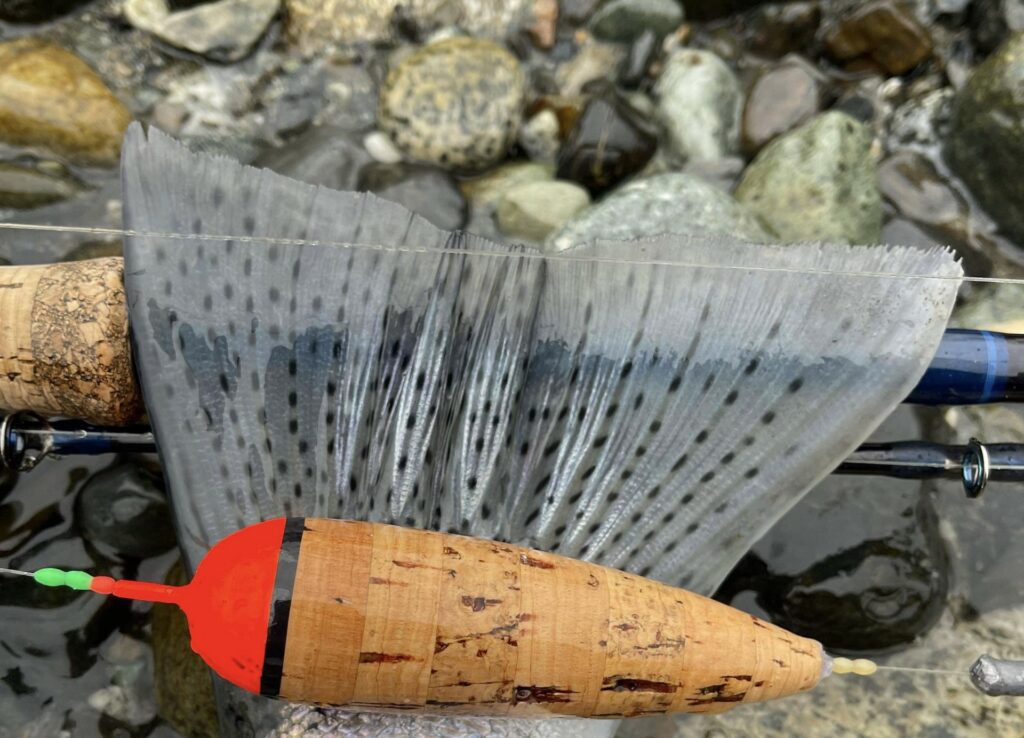
Thankfully, it looks like temps are going to rise early next week, which should get things back to normal fairly quickly. If you plan on heading out during the cold snap, be sure to dress appropriately, drive carefully and exercise caution on the river. There will be ice on the bank, and a slip/fall into the water in these temps can turn into a life-threatening event very quickly when it’s -20° with windchill. Those of you with felt-sole wading boots will want to be mindful of the fact that your felt soles will retain water and can freeze solid if it’s cold enough, which can make things sketchy. Be safe out there!
Taylor Nakatani
Squamish River Fishing Report
It has been a great fishing season so far when it comes to warm weather and rain. If you looked out the window yesterday, you know that that has all changed. We are currently in our first major cold spell of the season and with it comes cold weather fishing conditions. The Squamish has dropped hard and is now in the 2.0 poor fishing levels.
Why is low water bad? Simply put, low water is clear and cold. This shuts down the bulltrouts’ and rainbows’ metabolisms and the clear water makes them more aware of lines, hooks and anglers.
All is not doom and gloom. The cold spell shouldn’t last long. We will see things warm up again next week and with a little rain we will be back in business.
If you are heading out this weekend, fish small presentations, fish the deep holes and fish slow. Also bring a shovel in your car. Even if a road is almost clear, turning around can be a major problem on the service roads with snowy shoulders.
In our report two weeks back, we looked at a detail overview of indicator nymphing on the Squamish. Click here for that report and scroll down to the Squamish Report. This week with cold weather in mind we are looking at straight line nymphing. It is one of the most effective and methodical nymphing techniques for tough conditions.
Check it out below.
Matt Sharp
Winter Cutthroat Fishing
With most lakes and Stillwater fisheries being at a full-stop outside of ice fishing, a great way to wander a river is to chase winter cutthroat. Taking a break from swinging the longer rods on rivers, lighter trout rods are a welcomed change.
With cutthroat being as nomadic as they are, they can be found in various backchannels and sloughs that make up the Fraser Valley. Where you found cutthroat trout the day before may be devoid of life today or tomorrow. Keeping that in mind, it is often a good idea to be prepared to walk and wander some distance while in search of these traveling fish.
Dusting off that fold out map and looking at the various blue lines can be a great idea.
Lighter trout rods mentioned above are the preferred sticks of choice, with 4wt and 5wt rods being the norm.
Most anglers will target these fish with full floating lines paired with light leaders and tippet. Keeping a few spares in your kit is a good idea as sometimes more flies end up in the trees or bushes that line the sloughs.
Common patterns for winter cutthroat may include small soft-hackles, bugger-style patterns, baitfish, and nymphs.
Even small poppers can be effective as Winter becomes Spring. Small buggers or leeches in various colours and shades are a great catch-all pattern as they can represent leeches, aquatic worms, drowned worms, and small shrimp.
With that in mind, scuds are a pattern that are often left out of one’s box or are a last thought when targeting these trout in coastal streams and sloughs when they should be a welcomed addition.
Keeping a journal that tracks your encounters with these fish may pay off in the long run as often times these fish will follow the food, and learning the patterns of where that food is and when, can sometimes narrow down where and how far you may have to wander.
Remember to respect private property and to wade with caution, as ground that feels firm or frozen may be soft underneath where it is warmer.
Jordan Simpson
EURO NYMPHING
Euro Nymphing AKA: tight line, French, Polish, Czech, Competition, Contact Nymphing.
Whatever you call it, it’s one of the most productive methods for fishing fast moving water. Originally these techniques were developed to purely find as many fish as possible in a competition setting. I think we can take some direction from the competition world and simplify the method to best suit our coastal rivers.
So, what is it and why does it work?
In its simplest form tight line nymphing is basically high sticking with a weighted fly and a long leader. In the leader we usually include some hi-vis coloured line to act as a strike indicator or “Sighter”. No fly line is on the water. The connection is direct to the fly. It’s simple to see why this works so well. A heavy fly sinks fast and stays near the bottom. The lack of fly line on the water allows a very controlled natural drift. The direct connection to the fly allows for quick hook sets, and the sighter will show any light takes that can’t be felt through the rod.
– Pros: Allows one to fish faster water that would normally be impossible with an indicator. Allows you to keep you fly “in the zone” longer. Allows technical fishing around structure and small pocket water. This is especially important during low and clear conditions when fish will push up into the head of a run under faster water for shelter.
– Cons: Not meant for distance casting. Requires heavy flies. Not the best option for fishing slow water. Your arm gets tired from all the fish you catch.
Rods:
Longer rods will give you an advantage. 10 ft rods are very common for nymphing, and euro specific rods will reach up to 11 ft. Your average 9ft 4-5wt will work to get the job done. Euro specific rods generally have softer tips to protect light tippet and help lob weighted flies without the assistance of fly line. Rod/Line ratings are also a little different on euro specific rods; almost like spey ratings where you size up by two. Common euro weight rods are 3-4 weights for trout and up to a 6 weight for salmon and steelhead.
Reels:
A good nymphing reel usually has a large arbour for quick line pickup, and a narrow low volume spool as we don’t usually have much line on the reel. Euro specific reels take this one step further and includes additional weight in the reel to balance the longer rods.
Lines Systems:
This is where the system really departs from traditional fly fishing. There are a number of different line systems we can use but one thing they all have in common is that they are not meant to cast for distance. Euro specific lines are very low diameter lines meant to act as a handling section when fishing long leaders. The thin line is sensitive to strikes and most importantly dose not sag as much when high sticking. Lines can roughly be divided in to 3 categories. Full length /competition lines, short lines and mono rigs.
– Full length Euro/FIPS: These are full length lines meant to spool a reel for dedicated euro nymph duty. These are thin, sensitive and most will comply with international competition rules. Many have a long mono section integrated in the tip for you to tie in a sighter and leader.
– Short lines: These are a shorter coated lines usually in the 20-30 ft range designed to attach directly to your existing fly line. Again, these have a long mono section integrated into the tip for you to attach a sighter and leader directly. These are versatile and can change any floating line setup to a euro nymph rig. A popular choice for quick changes on water.
– Full Mono Rigs: As it sounds, we lose the special line and just run mono. This is not competition legal but very effective. 30 ft of mono can be used instead of fly line. This gives the system the least amount of line sag, but it can be difficult to handle in cold weather. If you fish smaller streams or slower water, you may want to go with a lighter mono. Heavier mono will be easier to cast but have more sag … lighter mono will have the least amount of sag but will be harder to cast. These have become popular and even come premade on a spool with loops and sighter built in. Another popular way to change rigs on the water.
Sighter and Leader:
Sighter is a supple hi-vis two or three coloured mono. This is used as a strike indicator. I commonly use 1x-3x depending on the target fish. Leaders should be Flourocarbon! and really makes a difference. Flouro is dense and sinks faster than mono. It is also clear underwater giving the best presentation. My leaders are usually 2x-3x and my tippet is 4x-5x. Keep in mind you can fish lighter or heavier if needed. Thinner diameter leaders will cut through the water faster and offer the best drift.
Flies:
Two words… Jig and Heavy. Most of my flies will be tied with slotted beads on jig hooks. This drops the fly in to the zone and drifts with hook point riding up. This also improves hook placement with most fish hooked in the hard top of palate. I usually fish stone flies in a variety of sizes in the spring and summer and devastatingly effective egg patterns in the fall and winter. Many traditional patterns can be adapted to work on a jig hook. Have a range of flies in different weights. 2 – 4.5 mm slotted tungsten beads will be most common. Wide gap hooks are also helpful when tying bulky egg patterns. For egg patterns I like tying with Mc Fly foam and FNF Slush Jelly. Both are available in a wide range of colours and make great egg imitations.
Tippet rings:
Little rings that replace line to line knots. Some people love them some don’t. I use them and like the ability to add tippet or re tie quickly.
What I fish:
I have settled on a fairly simple mono rig. This is a long section of 20 lb hi-vis mono about 3O feet. This is attached with a large loop to loop knot to my regular floating line. My fly line stays on the reel and I only fish with the mono. From here, I tie in 3-4 ft of two-toned sighter. At the end of the slighter I add a tippet ring and tie in a leader, 4-6ft depending on where I am fishing, followed by another tippet ring and finally my actual tippet 18-24 inches to my fly. Flies are tied with a small no slip loop knot. When I approach a run, I fish it from the bottom up. I start at the tail out and work back up towards the head of the run. This lets me hook and play a fish without it spooking the pool. I am usually casting up stream, driving the flies in to the water keeping the sighter up off the water. Once the fly is at depth, drifting in the bottom foot, you will see a noticeable downshift in speed. This is because your fly is traveling in the slower water closer to the bottom of the river… right where the fish are. Keep direct contact with the fly and drift the pattern along the bottom. Allow the fly to drift past you and eventually swing out below you. Work the run in a grid pattern from top to bottom. The interesting part of this rig is I can spool off the mono and still have my floating line available to fish with.
Pro Tip:
Leave half inch tag ends on your sighter junction knots. The tags act as an added indicator to help see the slightest bumps in the sighter. I go as far as adding two additional unit knots with tags in my sighter. This really exaggerates the movement of the line and helps detect the smallest of bites. If you’re waiting to feel the hit your missing fish, look for small bumps, stalls or direction changes in the sighter and set on everything!
As with any new technique, it takes time to learn but it’s a great trick to put up some decent numbers on your next outing. Have fun, stay safe, don’t tell your friends what you’re using.
Cheers,
Eric Peake


